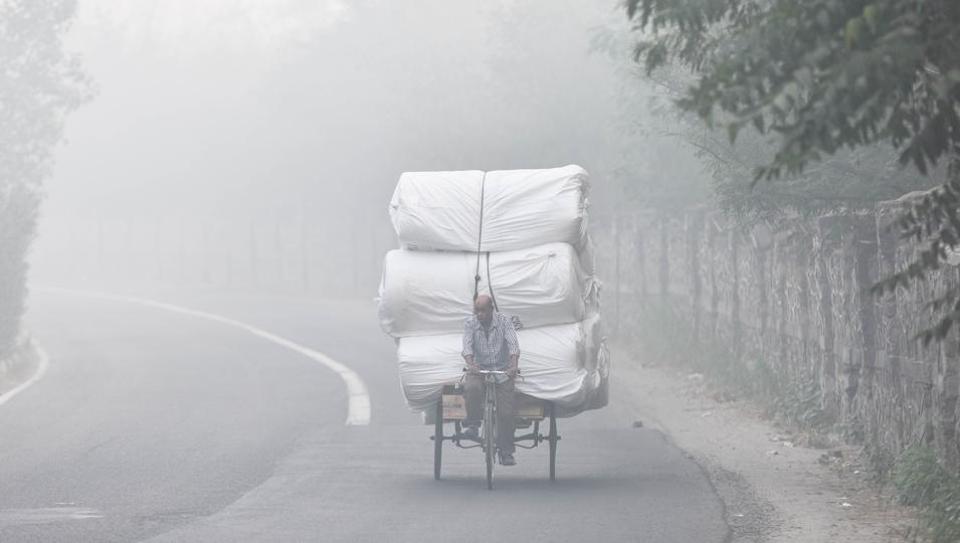Play all audios:
DELHI’S AIR IMPROVES SLIGHTLY, RECORDED AS ‘VERY POOR’ AFTER SIX CONSECUTIVE DAYS IN ‘SEVERE’ ZONE Hindustan Times, New Delhi | ByKainat Sarfaraz Nov 11, 2020 08:24 AM IST THE IMPROVEMENT
FROM “SEVERE” TO “VERY POOR” CATEGORY WAS LARGELY DUE TO THE WIND SPEED GATHERING MOMENTUM AND AN APPRECIABLE DIP IN FARM FIRE INCIDENTS IN PUNJAB ON TUESDAY The air quality index (AQI) of
Delhi showed a marginal improvement on Wednesday morning after six consecutive days of pollution in the “severe” category. The AQI was in the “very poor” category as the early morning
recording of 394 showed. The improvement from “severe” to “very poor” category was largely due to the wind speed gathering momentum and an appreciable dip in farm fire incidents in Punjab on
Tuesday. An AQI between 401 and 500 and from 301 to 400 is considered in the “severe” and “very poor” category, respectively. Poor AQI causes distress and respiratory illnesses, especially
among the vulnerable population such as children and senior citizens, according to the Central Pollution Control Board (CPCB). ALSO READ: WORST EPISODE OF SMOG NEGATES ALL GOOD AIR RECORDS
IN DELHI The minimum temperature in the national capital recorded at 6.10am on Wednesday was 12 degrees Celsius (C). There was no fog, only mist. On Tuesday, at around 9:30 am, at least 18
stations in Delhi had reported an AQI of 500, which is the maximum on the pollution measurement metric. A few private air quality monitoring platforms had even reported an AQI of 999,
indicating that the pollution measuring values had hit the maximum level. On Tuesday, the average 24-hour AQI in Delhi was 476, according to CPCB data. The past six days was one of the
longest spells in the nation capital’s brush with “severe” air quality. Scientists said that Wednesday’s improvement was primarily due to a change in wind speeds. According to the Tuesday’s
bulletin of System of Air Quality and Weather Forecasting and Research (SAFAR), a national initiative introduced by the Union Ministry of Earth Sciences (MoES), the wind condition further
aggravated Delhi’s pollution woes. The national capital is reeling under stubble burning in neighbouring Haryana, Punjab and also parts of western Uttar Pradesh (UP), which has become an
annual feature around this time of the year. “AQI is likely to improve on Wednesday. It will hover between the lower end of ‘severe’ and the higher end of ‘very poor’ category owing to a
likely change in wind direction and marginally better ventillation condition,” the bulletin said. “A few hundred farm fires were raging on Tuesday, as compared to thousands in the past week.
Winds are also picking up. We are expecting an improvement in the pollution level,” said Vijay Soni, a scientist with India Meteorological Department (IMD). The weather bureau has predicted
that Wednesday would be foggy. The maximum and minimum temperature’s forecast is 30 and 11 degrees C, respectively. On Tuesday, the minimum temperature had dropped to 10.7 degrees C --
three degrees below normal -- and maximum temperature stood at 30.1 degrees C – a notch above normal. * Delhi * Central Pollution Control Board * Air Quality Index Catch every big hit, every
wicket with Crickit, a one stop destination for Live Scores, Match Stats, Infographics & much more. Explore now! Stay updated with all top Cities including, Bengaluru, Delhi, Mumbai and
more across India. Stay informed on the latest happenings in World News along with Delhi Election 2025 and Delhi Election Result 2025 Live, New Delhi Election Result Live, Kalkaji Election
Result Live at Hindustan Times. Catch every big hit, every wicket with Crickit, a one stop destination for Live Scores, Match Stats, Infographics & much more. Explore now! Stay updated
with all top Cities including, Bengaluru, Delhi, Mumbai and more across India. Stay informed on the latest happenings in World News along with Delhi Election 2025 and Delhi Election Result
2025 Live, New Delhi Election Result Live, Kalkaji Election Result Live at Hindustan Times. News / Cities / Delhi News / Delhi’s air improves slightly, recorded as ‘very poor’ after six
consecutive days in ‘severe’ zone See Less

